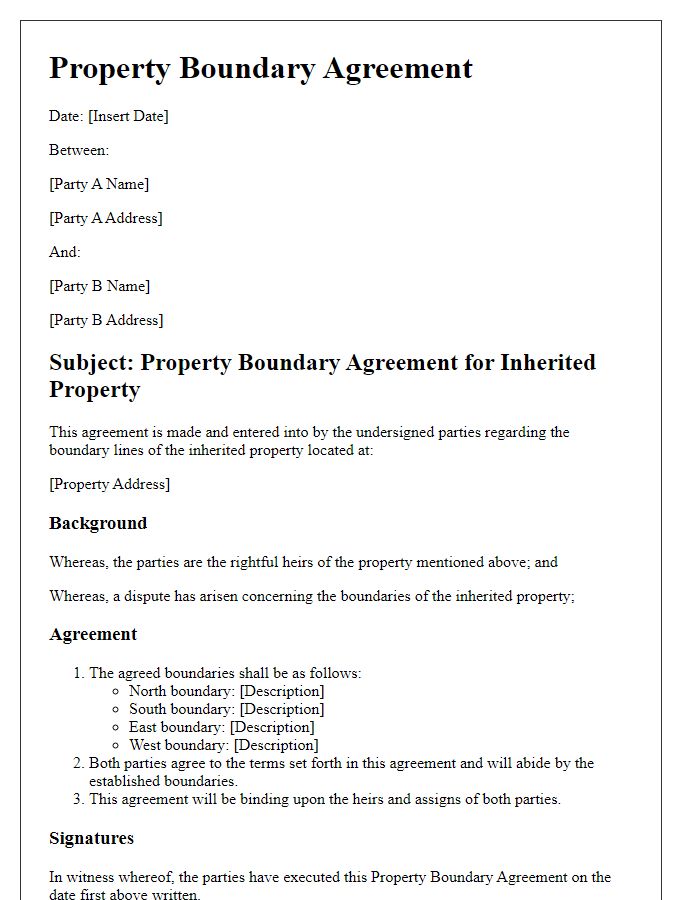Are you facing challenges with your property boundaries? A well-drafted boundary agreement can help clear up discrepancies and establish a mutual understanding between neighbors. This letter template serves as an effective tool to formalize your discussions and create a legally binding document. So, let's dive in and explore the essential components of a property boundary agreement!

Precise property descriptions
A property boundary agreement defines the specific dimensions and limits of two or more adjacent properties, ensuring clarity and reducing disputes. This agreement typically includes precise property descriptions that may reference landmarks, such as Oak Tree at the northern corner or the Stone Wall along the eastern edge. Measurements often include linear dimensions, such as a 150-foot stretch along Elm Street and a 200-foot depth extending toward the creek. The use of a professional surveyor's map (often outlined in legal terms) is critical, detailing the surveyed lines and angles, with the plot number referenced from the local county assessor's office. Additional terms might include easements or restrictions, emphasizing shared utilities or access rights.
Clear demarcation of boundaries
Clear demarcation of boundaries ensures legal clarity between adjacent properties, such as residential lots in Lakeview Estates, a community known for its picturesque landscapes. Adhering to local zoning regulations, property lines must be precisely mapped using survey markers, which are often established by licensed land surveyors. These markers, typically made of metal or durable plastic, provide definitive reference points that help prevent disputes between neighbors over land use. In cases of disagreement over boundary lines, property owners can refer to official documents filed with the county recorder's office, including the original plat maps or title deeds. Regular communication and mutual understanding between both parties can facilitate a harmonious relationship and prevent future conflicts regarding land development or maintenance responsibilities.
Agreement terms and conditions
Drafting a property boundary agreement requires careful attention to the details of the terms and conditions that both parties must adhere to. The agreement should clearly outline the specific boundaries of the property in question, referencing surveys or maps (e.g., GPS coordinates or plat maps) to avoid ambiguity. It should include stipulations regarding maintenance responsibilities for fences or hedges that demarcate the border. Additionally, the document must specify the rights of access for both parties, ensuring both can utilize their properties without infringing on the other's space. Any alterations or developments planned within close proximity to the boundary should be discussed, detailing permissions required. Furthermore, provisions for dispute resolution, such as mediation or arbitration, should be included to resolve any future disagreements amicably. Finally, the agreement should be signed by both parties in the presence of a notary public to ensure its legal enforceability.
Signature blocks for involved parties
A property boundary agreement establishes clear delineations between neighboring parcels of land, ensuring that both parties understand their respective rights and responsibilities. The agreement typically includes detailed descriptions of the properties involved, notable landmarks, measurements in feet or meters, and any existing structures near the boundaries, such as fences, walls, or trees. Signature blocks at the end of the document provide designated areas for each party to authenticate their consent, including their names, signatures, and dates of agreement, ensuring legal validity and mutual acknowledgment. Additional notations may specify the involvement of legal representatives or witnesses, enhancing the veracity of the agreement in case of future disputes.
Conflict resolution clauses
In property boundary agreements, conflict resolution clauses play a crucial role in ensuring that disputes between neighboring property owners are addressed efficiently and effectively. These clauses typically outline procedures for mediation or arbitration, emphasizing the importance of open communication and cooperation. For example, if a dispute arises regarding the exact property lines, the agreement may stipulate that both parties must first seek a mediator certified by a professional organization such as the American Arbitration Association (AAA). This mediation process often allows for a neutral third party to facilitate discussions and propose solutions, thus avoiding costly litigation. Additionally, the agreement might establish timelines for resolution, such as requiring mediation to occur within 30 days of a dispute being raised, ensuring timely resolution. Furthermore, the clauses may include provisions for legal fees, indicating that the losing party in any arbitration settlement may be responsible for covering the other party's legal expenses. By outlining these mechanisms clearly, property boundary agreements foster a spirit of cooperation and mutual respect between neighbors, ultimately benefiting both parties involved in the property ownership.
Letter Template For Property Boundary Agreement Samples
Letter template of property boundary agreement for neighbors resolving disputes

Letter template of property boundary agreement for formalizing land divisions

Letter template of property boundary agreement for easement negotiations

Letter template of property boundary agreement for shared fence installation

Letter template of property boundary agreement for commercial property delineation

Letter template of property boundary agreement for residential lot adjustments

Letter template of property boundary agreement for joint land development







Comments